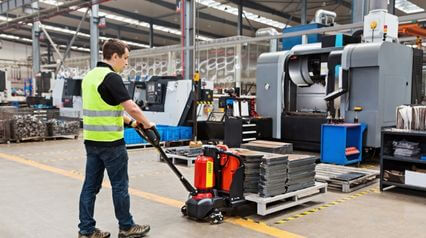Material handling equipment plays a vital role in the operation of a warehouse. It is necessary to move items from the goods reception area to the storage area and then to the dispatching zone.
The market offers a variety of handling equipment that can be tailored to fit any area or operation within the warehouse. You need to know your options well in order to select the best conveyance solution for each logistical requirement.
Material handling equipment in a warehouse is crucial. The efficiency of your warehouse depends largely on it. This equipment will help you to speed up your operations, cut down on logistics costs, and reduce the risk of accident.
What is material handling equipment?
Handling equipment in logistics is defined as a machine that transports, stores, controls and handles materials, products and goods during manufacturing, storage, and distribution processes.
The vast majority of industrial buildings, such as warehouses, production facilities and distribution centres, have material handling equipment.
Handling equipment in a warehouse is responsible for loading, unloading, and transporting of goods between receiving, storage zones, order processing zones, and dispatch areas. To maximise productivity, specific handling equipment is required for each area.
Forklifts, pallet jacks, and automated conveyors are all examples of material handling equipment in melbourne that is used in warehouses.
Material handling equipment types in warehouses
Material handling equipment in logistics facilities can be divided into three main groups:
1. Manual material handling equipment
Humans are the only ones who can operate manual material handling equipment. Pallet jacks are the most common machines used in manual warehouses. The pallet jack’s parallel forks enable it to lift and support heavy loads, while also lifting them off the floor to make their transportation easier.
Pallet jacks can be used for a variety of operations, from loading and unloading trucks to moving pallets and containers. Pallet jacks can be used in picking operations.
We also have lift tables for ergonomic order preparation, hand trucks to transport boxes and unpalletized load and picking carts.
2. Motorised material handling equipment
Workers operate motorised material handling equipment from a platform, cabin or other enclosed area.
There are many motorised material handling machines in the forklifts category. Reach trucks are preferred in warehouses that have similar products. Counterbalanced forklifts, on the other hand, are popular because of their versatility.
Narrow aisle forklifts are used in places that handle a wide variety of goods, but need to optimize space. Side loader forklifts can be used to handle very large or long loads.
Order pickers are also included in this category of motorised material handling devices. These machines help operators pick products, particularly those on lower shelves.
3. Automated Material Handling Equipment
A warehouse control system (WCS), which manages all machine movement, is used to operate automated material handling equipment. In this category, the stacker cranes are a standout for their agility and capacity in storing goods and retrieving them from racks.
There are many types of stacker cranes, including AS/RS trilateral AS/RS stacker cranes. This is a good option for warehouses that already use trilateral turret tractors and want to automate their operations without disrupting them.
Another type of material handling equipment that is used in automated warehouses are roller and chain conveyors. Conveyors are used to move boxes and pallets within a facility. They also connect different zones or the warehouse area with production lines. Automatic guided vehicles (AGVs), and autonomous mobile robotics (AMRs), are also extremely useful in environments where materials flow continuously and repetitively. They save time and boost productivity.
Pallet lifts, on the other hand are an excellent solution to overcome height differences in automated storage systems and retrieval (AS/RS) and move goods vertically. While transfer cars move goods from one place to another, automated Pallet Shuttles are used to move pallets within the storage channels of the rack.
The importance of selecting the right material handling equipment
What material handling equipment will I need in my warehouse? Many logistics managers have asked this question when selecting handling equipment for their operation. The selection of the right handling equipment is crucial because it will affect the design of the warehouse and the number operators required in the facility.
The type of equipment required will depend on the storage system and goods being stored. Side loader forklifts are used to store long products in cantilever racks. For picking small items, order pickers or picking carts are used.
During your selection process, it is important to determine whether you want to invest in automated or manual material handling equipment. Manual equipment is cheaper and does not require any previous installation. Depending on your company’s volume of business and logistic requirements, automated material-handling equipment may be the best option for streamlining warehouse operations.
Material handling equipment is the heart of the warehouse
Racks are essential for every logistic facility. Without them, goods can only be stored on the floor. It’s also important to have the right material handling equipment for transporting, loading and unloading goods.
Material handling equipment and racks are essential for efficient logistic operations. The warehouse’s smooth operation is dependent on both elements.
Want to increase the efficiency of your material handling and storage equipment?


